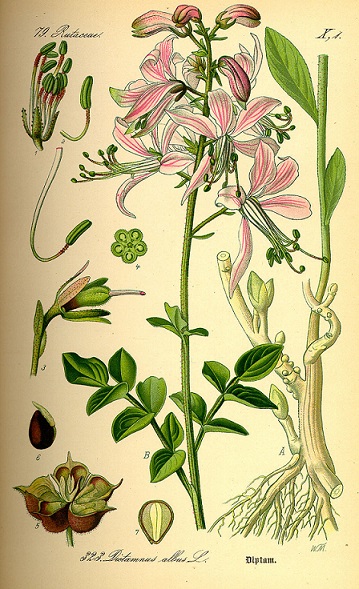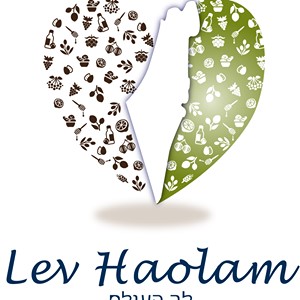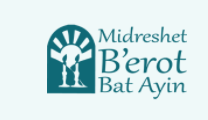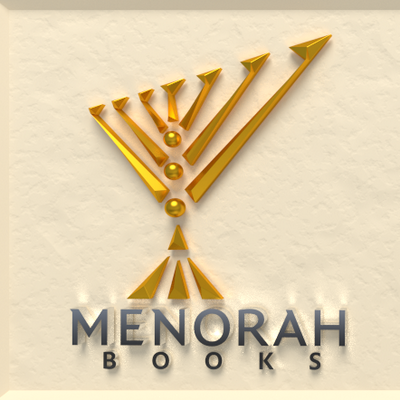Super Free stock/ Getty Images 2013
Dictamnus Albus is a very unique bush. The fragrance is lemony and quite pleasant. If you touch the plant, you will feel the oils produced. Some, consider this to be the burning bush referred to in the Torah (Bible). Before you go and touch this plant you should be aware that it causes skin reaction for some people where exposure to the sun produces blisters. Despite the lemon-like smell, the plant is acrid when eaten. Though it is sometimes referred to as a herb all parts of the plant may cause mild stomach upset if eaten, and contact with the foliage may cause phytophotodermatitis.
More than 100 chemical constituents have been isolated from the genus Dictamnus, including alkaloids, limonoid triterpenoids, flavonoids, sesquiterpenoids, coumarins, and phenylpropane. A flowering shrub grows to a height of about two feet. Native to a wide swath of Europe and Asia, including Israel, it’s commonly called “fraxinella,” “dittany,” and, more pertinently for our story, “gas plant” and “burning bush.” On warm days D. albus exudes oils that produce vapors that readily ignite if you hold a match to it, and some say it ignites all by itself if the sun is hot enough. But — here’s where things start to get biblical — the vapor burns so quickly that it doesn’t consume or even damage the plant. This naturally brings to mind Exodus 3:2: “And the angel of the G-d appeared unto [Moses] in a flame of fire out of the midst of a bush: and he looked, and, behold, the bush burned with fire, and the bush was not consumed.”

Free super stock getty/ images
So D. albus is Moses’s burning bush, right? Many Torah commentators think so (or at least they think the bush was a spontaneously combusting plant). The event occurred on Har Sinai or Mount Sinai. A granite stone from the area of Mount Sinai shows what seems to be a depiction of a bush, created naturally by a concentration of manganese oxide which forms into this shape in the rock. It certainly does look like the D. albus bush.
 Photo by Mushki Brichta 2014
Photo by Mushki Brichta 2014
Stones near the burning bush bear fossil-like markings which are engraved in the granite rock. It is said that it was here where the miraculous fire of God appeared in the bush and God spoke to Moses.
Local guides explain that fossils cannot be seen in any granite stone, only limestones. Mt. Sinai is mainly made up of granite stones. These are NOT fossils that appear in the granite stone. They explain that since God touched the mountain itself (when he gave Moses the 10 commandments), and spoke to him through the Burning Bush, the fossil-like imprint appeared on the stones which look just like the Burning Bush.
It seems that many believe that the patterns were caused by a divine light, so intense that the shadows of the plant were imprinted in the stone leaving imprint which is identical to the leaves of the Burning Bush. It may be explained that the powerful spiritual radiation of the fire of God left its print in the rock like radiation from an x-ray machine leaves images on x-ray plates.
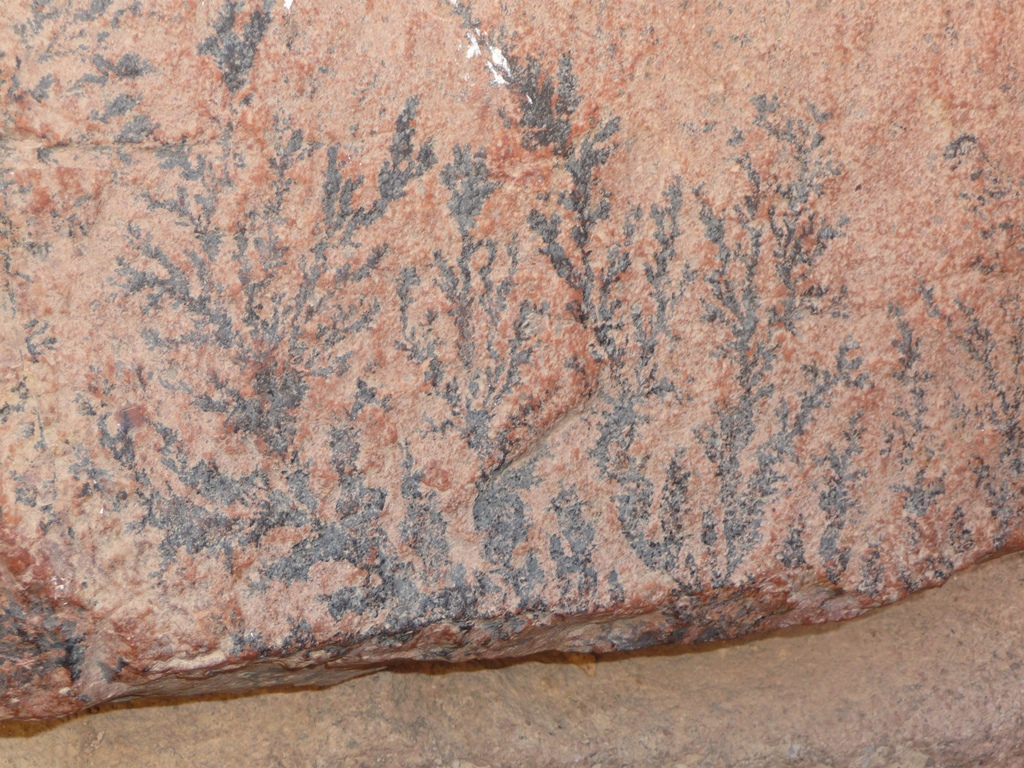 One rabbi commented that the stones were branded by God with internal engravings of bush-like shapes in memory of the incident of the burning bush that allegedly took place there. He wrote:
One rabbi commented that the stones were branded by God with internal engravings of bush-like shapes in memory of the incident of the burning bush that allegedly took place there. He wrote:
“The Mysterious Rocks from Mount Sinai: No matter how you split rock from Mount Sinai, you will see on all sides mysterious engravings of a bush. I’ve witnessed this personally and can testify that it’s true. (this is a unique phenomenon in the world) I once heard an explanation in the name of a Midrash: ‘ When G-d sent Moses to Egypt to report to the Jews about the redemption and then to come back to Mount Sinai, Moses asked G-d: ‘how will I be sure which mountain to return to?’ (since at first, G-d spoke to Moses only from Mount Sinai). G-d made a miracle and all the rocks from Mount Sinai became engraved with the ‘burning bush.” ~Rabbi Binyamin Levin
The Midrash says the rocks would be engraved as a sign. While geological dendrite-type features may appear in other parts of the world, this exact form does not appear anywhere in this area except for that of Mount Sinai. Other candidates alleging to be Mount Sinai have no such sign engraved in their stones. It would stand to reason the Midrash says, “Don’t search in India or any other ridiculous places in the world for Mount Sinai. Instead, look in the Sinai Peninsula and then look for the autograph G-d put on it.” Local Beduins, who know the peninsula intimately, attest no such autograph appears in any other mountain in the peninsula. No other mountain stones behave as Mount Sinai stones.
It is believed by many Torah Commentators that the oils from this plant were used in the Temple but is not clear where in the Temple service it was used. This oil from this plant has been described and identified possibly as “maaleh ashan” the smoke producing herb may have been used in the Ketoret Temple Incense. When you take a match to you will notice the flame goes straight up perfectly which explains how the smoke would go up straight when used in the Ketoret incense. This is only speculation and only a descendant of the Avtenas family would know for sure what herb was used. Avtenas family were the only formulators of the family Ketoret recipe that was revealed to Moses on Har Sinai Moses gave specific instructions to the Avtenas family on how to formulate the mystical incense blend for Temple service.
There is a reference to G-d speaking to Moses in the burning bush. A story told by Rabbi Akiva that a crying little boy a descendant of the Avtenas family said G-d will gladden his descendants at the end of days, it was a reference to G-d telling Moses that he will redeem all of the Jewish people from Gulus (exile). This is also referring to the current cries of the Jewish people. The burning bush might be maaleh ashan, if it is the revelation that is to come in the last days before Moshiach comes this will ultimately bring back the secret of Ketoret and how the smoke of the incense ascended straight up to the shamayin (heavens).

The smoke of incense flowing from a burner. The Temple incense the smoke went straight up and was very clear almost blue
“Rabbi Akiva related: Shimon ben Luga told me that once (after the destruction of Holy Temple), he and a young lad – a descendant Avtinas family – were gathering herbs in the fields. ‘I noticed that suddenly the boy wept, and then laughed. I asked him, ‘my boy, why do you cry?’ And he told me, ‘For family’s honor, which has been diminished.’ ‘And why did you laugh?’, him. ‘Because the greatest honor is reserved and established for the righteous in the future world. And in the end result, the Holy One will gladden his descendants, may it be speedily.'”
“I asked the boy, ‘what did you see that reminded of all this?’ And he told me ‘As we were gathering, saw plant ma’aleh ashan before in field.’
‘Show it to me!’ I exclaimed. But he told me, ‘We have a tradition never to show it to any man.’ Only a few days passed, and that child died. Thus he did not reveal it to anyone.”
The question is would the full plant be used to mix into the Ketoret or was it just the leaves and flowers? We will never know for sure until it is revealed by G-d, but for now, it is certainly something to think about.

Description
Ketoret Blend of 11 Blue Colbalt Bottle 10 ml
Eleven Temple Incense Organic Oils blended
together. 10ml
Although there are strict prohibitions against experimentation with the various plant materials in their original raw form, we have been advised by our highly respected teachers in Jerusalem that there is no prohibition whatsoever against the enjoyment of the Essential Oil extracts of these same botanicals. In fact, we have been greatly encouraged to use and enjoy them, and to make these very special and beautifully highly fragrant organic pure oils available to all of the klal scattered across the world and among the nations of b’nei Noach.
Balsam
Cassia
Cinnamon
Cinnamon Bark
Cistus-(Rose of Sharon)
Frankincense Resin
Galbanum
Myrrh
Onycha (Benzoin)
Clove
Spikenard Resin
From Israel
During the days of the Temple, the exact method of Ketoret preparation by the Master Perfumer was a closely guarded secret. Today we are still unravelling the mystery of exactly which ingredients and processes were used to formulate the finely ground mixture. Although there are still varying opinions and speculation about some aspects of the Ketoret, the wise ones among us have been able to identify the exact botanical sources of the main ingredients. Which oil can be extracted to create a healing blend
Temple Incense Components – Set of 11 Jars Here
Perfect for Havdallah, and a Segulah (Protection) for the home. Jewish Sages and Rabbis have taught that the experience of these Holy fragrances helps to speed up the rebuilding of the Bet HaMikdash (Third HolyTemple).
Purifies the air,many medicinal uses and anointing of living and work space which are all for the purpose of healing..
Please Note: While it is forbidden to reproduce the sacred Temple incense grounded materials ( is not oil) according to the precise instructions received by Moses and handed down by our sages for use outside of the Holy Temple. Our incense essential oils blends are created with care that do not to violate this sacred principle of the grounded materials used in the Temple. The essential oil blend can be enjoyed for personal and healing purposes only.

